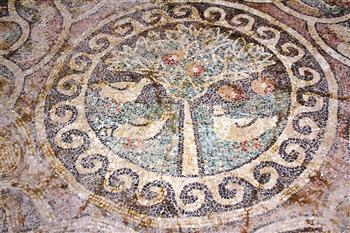The latest findings at the Amasya excavations, 2,000-year old Roman mosaics, bear many similarities with the Zeugma mosaics.
Source - http://www.hurriyetdailynews.com/excavations-reveal-the-first-mosaics-in-amasya.aspx?pageID=238&nID=49962&NewsCatID=375

Experts see many patterns in the mosaics such as ropes, geometric shapes and flowers, and they are all designed as a composition arrangement. AA photos
The 2,000-year old Roman mosaics unearthed during recent excavations in the northern province of Amasya will turn a new page in history, according to officials. The mosaics have similar features to the famous Zeugma mosaics in Gaziantep.
Speaking to Anadolu Agency, Amasya Governor Abdil Celil Öz said the unearthed Roman mosaics would open a new page for Amasya and a new era in the history of archeology.
Öz analyzed the excavation area and mosaics with Çorum Hittite University’s Black Sea archeology research and application center manager assistant professor, Esra Keskin, provincial tourism manager Ahmet Kaya, and museum manager Celal Özdemir.
Noting that Amasya had a history going back 8,000 years, Öz said the excavations enlightened ancient times, revealing crucial information. “The mosaics in Amasya have similar characteristics to Gaziantep’s Zeugma area,” he said. “These mosaics are believed to be the witnesses of history and they will open a new era to unraveling history.”
One of the unearthed mosaics includes a diamond that is believed to signify Amasya. The province’s symbol is muscatel apple, which also features in the middle of another mosaic. “The muscatel apple has become the brand of the city,” said Öz.
Bird figures and shapes are another representative image of the ancient times of Amasya.
Noting that the excavations would continue in the area, Öz said he believed that in the end settlements would be found.
Assistant professor Esra Keskin said the mosaics were very original, and heralded possible further findings in architecture and archeology.
Two main parts
“The first era has two main areas. In the north and south, the main area is a rectangular shape and covered with all mosaics on the floor. The main area’s south part is like a horseshoe and there are large tiles on the floor,” said Keskin.
The 20 square-meter mosaic in the main area shows that high quality work was made in the past, according to her.
In this technique the stone pieces, which are defined as “tessera” are cut in rectangular and prismatic forms, form a composition when gathered together. These are the languages and the shapes that reflect the art and aesthetic style of ancient times.
Noting that experts see many patterns such as ropes, geometric shapes and flowers, Keskin said these were all designed as a composition arrangement.
There are many natural descriptions in the images, reflecting the artistic approach and also prompting us to ask whether they symbolize anything in particular, she added.
Mosaics sent to Amasya Museum
The unearthed mosaics may now be sent to Amasya Museum, said Keskin.
She said the work was unique in the international arena and added that there were many symbolic clues that these mosaics could give us. There are many similar characteristics and motifs between the Amasya and Zeugma mosaics, but the differences are still very significant, said Keskin, adding that these excavations’ results revealed the rich potential of Amasya